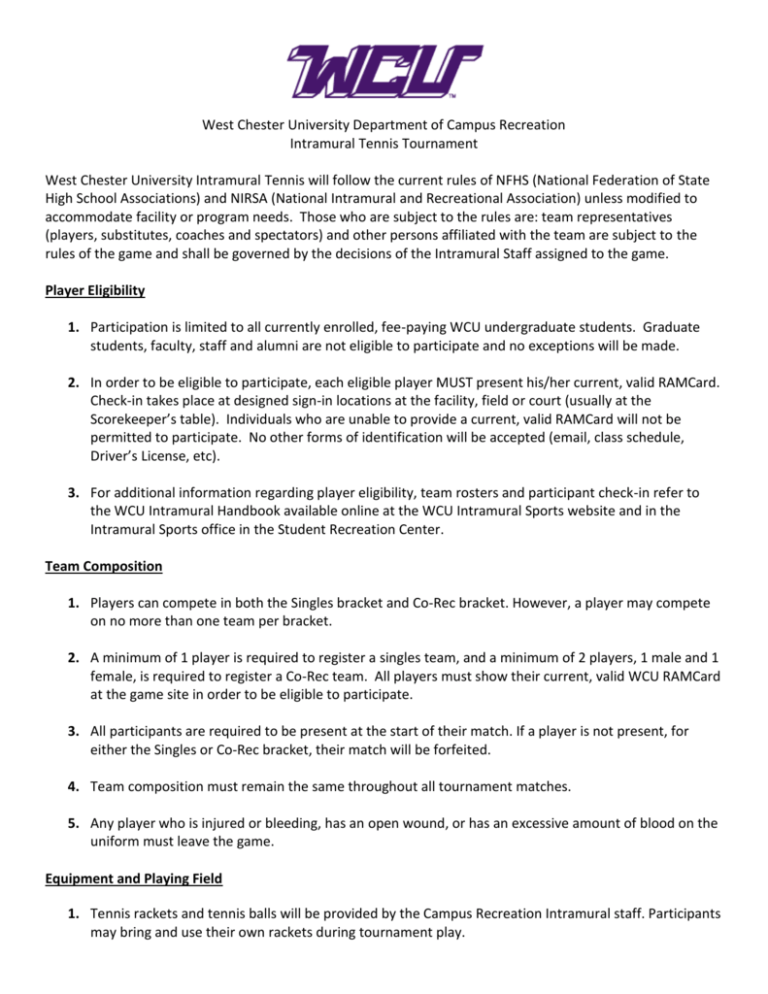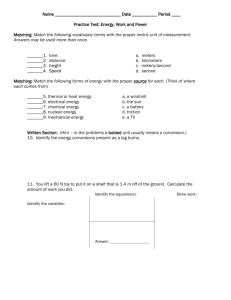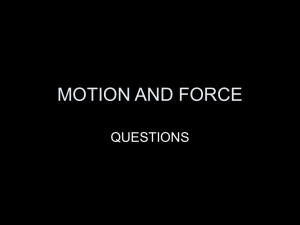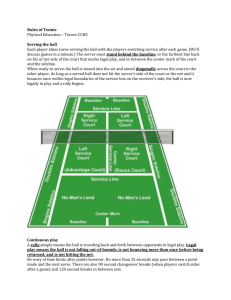Tennis - West Chester University
advertisement

West Chester University Department of Campus Recreation Intramural Tennis Tournament West Chester University Intramural Tennis will follow the current rules of NFHS (National Federation of State High School Associations) and NIRSA (National Intramural and Recreational Association) unless modified to accommodate facility or program needs. Those who are subject to the rules are: team representatives (players, substitutes, coaches and spectators) and other persons affiliated with the team are subject to the rules of the game and shall be governed by the decisions of the Intramural Staff assigned to the game. Player Eligibility 1. Participation is limited to all currently enrolled, fee-paying WCU undergraduate students. Graduate students, faculty, staff and alumni are not eligible to participate and no exceptions will be made. 2. In order to be eligible to participate, each eligible player MUST present his/her current, valid RAMCard. Check-in takes place at designed sign-in locations at the facility, field or court (usually at the Scorekeeper’s table). Individuals who are unable to provide a current, valid RAMCard will not be permitted to participate. No other forms of identification will be accepted (email, class schedule, Driver’s License, etc). 3. For additional information regarding player eligibility, team rosters and participant check-in refer to the WCU Intramural Handbook available online at the WCU Intramural Sports website and in the Intramural Sports office in the Student Recreation Center. Team Composition 1. Players can compete in both the Singles bracket and Co-Rec bracket. However, a player may compete on no more than one team per bracket. 2. A minimum of 1 player is required to register a singles team, and a minimum of 2 players, 1 male and 1 female, is required to register a Co-Rec team. All players must show their current, valid WCU RAMCard at the game site in order to be eligible to participate. 3. All participants are required to be present at the start of their match. If a player is not present, for either the Singles or Co-Rec bracket, their match will be forfeited. 4. Team composition must remain the same throughout all tournament matches. 5. Any player who is injured or bleeding, has an open wound, or has an excessive amount of blood on the uniform must leave the game. Equipment and Playing Field 1. Tennis rackets and tennis balls will be provided by the Campus Recreation Intramural staff. Participants may bring and use their own rackets during tournament play. 2. For doubles, participants are encouraged to wear their own like-colored jerseys. 3. Individual Player Equipment must meet the following requirements: a. Shirts: Shirts must be worn throughout the game. Shirts must not have arm openings that are larger than four inches. Officials will measure the arm openings with their fist. Shirts that have been altered and are missing more than the length of the sleeve will not be permitted. b. Pants: Players may not wear pants or shorts that have belt loops, metal, cargo pockets or exposed drawstrings. Players may not wear towels that hang from the waist. c. Headgear: Baseball caps or other rigid headwear is not permitted. Players may wear rubber or cloth elastic headbands that are used to control hair. Bandanas with knots are prohibited. d. Pads or Braces: No pads or braces may be worn above the waist. Leg and knee braces made of hard, unyielding material must be covered on both sides and all edges with slow-recovery padding. e. Shoes: All players must wear shoes. Athletic/Tennis shoes are permitted. Any other type of shoe that the official deem unsafe is prohibited. 4. Jewelry is NOT allowed to be worn by any participant during the game. Jewelry consists of visible rings (wedding bands), watches, necklaces, earrings, studs (including tongue or lip rings), bracelets (metal or cloth) and any other such similar jewelry. Medical alert bracelets must be taped to the body or secured under clothing such as a sock to be worn during play. Taping of any other forms of jewelry, other than a medical bracelet, is prohibited. Players are subject to ejection for failure to remove jewelry. Match Regulations 1. Match time is forfeit time. A bracket and tournament formatting will be created on the day of the tournament. 2. A match will be made up of the first team to win 7 games (not sets) - depending upon the total number of participants, or games will be limited to a 35 minute period (with a 5 minute warm-up). When the time limit is called, every game currently underway should be finished. If the outcome of that game results in a tie, the tie-break rule below should be used to determine a winner. This format is subject to change based upon the number of participants of the tournament. 3. There will be no officials provided for the Tennis tournament. All participants will officiate their own matches, and any disagreement on the result of a point should be replayed. 4. Tie Break: If a match is tied at six games each, a tie break will be played first to seven (7) points. Meaning, 15 =1 point, 30 = 2 points, 40 = 3 points, and so on until 7 points are reached. The winning player must win by two (2) points. Once a team has scored nine (9) points they will no longer have to win by two (2) and the first to ten (10) is the winner. Service will alternate every 2 points. Singles Play Rules Serving: 1. In tennis, play is started with the serve which is made by tossing the ball into the air and hitting it with the racket before it touches the ground. The server stands behind the baseline and to the right or left of the center mark, but not outside the singles sideline. 2. The serve for the first point of a game always begins to the right of the center mark and is made to the opponent's right service court. After each point is played, alternate service court. The same individual continues serving until the game is completed. 3. The server has two attempts to put the ball into play. 4. The serve is a fault if the server: Does not take the proper position before serving. Commits a foot fault. (Foot touches baseline any time prior to hitting ball.) Fails to hit the ball into the proper service court. Misses the ball in attempting to strike it. However, the server may toss and catch the ball without penalty. a. If any of these occurs on the first serve, it is a fault. b. If any of these occurs on both serves, it is a double fault, and the point is lost. 5. The ball must clear the net and land in the proper service court before being hit by the receiver. However, after the service, the ball may be hit before it bounces. A ball touching the line is considered in play. Scoring the Game: 1. The server is responsible for announcing the score before the service. The server's score is always called first. 2. A game equals four points. The scoring in tennis is 15 for the first point won, 30 for the second, 40 for the third point won, and "game" for the fourth point. A score of zero is referred to as "love". When each player has a score of 40, the score is "deuce", which means that one player must win two consecutive points in order to win a game. If the server wins the next point, the score is called "ad in" if he/she wins the following point, it is the game. If the receiver wins the first point after deuce, the score is called "ad out", and if he/she wins the next point, it is his/her game. However, if after the score is either "ad in" or "ad out", and the other player wins the next point, the score then becomes deuce again. Changing Sides: 1. The players change sides of court at the end of the first, third, and every subsequent alternate game of the set. During the tie break, sides are changed at a total of four points between the two players. Players change ends every four points. A Let: 1. A let is a ball which strikes the net, strap or hand, but lands in the proper court on the serve. 2. A let is called when a player is unable to play a shot due to circumstances beyond his/her control, such as interference by a ball or a player from another court. 3. A let occurs if a serve is delivered before the receiver is ready. If however, the receiver attempts to return the serve, he/she is considered to be ready. 4. When a let occurs on a serve, only that serve is repeated. 5. The ball is in play if it hits the net during the subsequent play after the serve. Player Loses Point: 1. If the ball bounces twice on a players side of the net or if a player does not return the ball to his/her opponent's court. 2. If a player's body, clothing or racket touches the net while the ball is in play. 3. If a player reaches over the net to play a ball unless the ball has bounced back over the net due to a spin or the wind. 4. If the ball is hit twice while on his/her side of the court. Doubles Play Rules: Serving: 1. In tennis, play is started with the service which is made by tossing the ball into the air and hitting it with the racket before it touches the ground. The server stands behind the baseline and to the right or left of the center mark, but not outside the doubles sideline. 2. The service for the first point of a game always begins to the right of the center mark and is made to the opponent's right service court. After each point is played, alternate service court. The same individual continues serving until the game is completed. 3. The order of serving is decided at the beginning of each set. The pair serving first decides who is to serve in the first game, and the other partner will serve in the third game. The opponents also decide who is to serve to first in the second game, and the other partner will serve in the fourth game. Both pairs alternate in the remaining games of the set. 4. The server's partner may stand anywhere during service. 5. If a player serves out of turn, the proper server must serve as soon as the mistake is discovered. All points earned are counted. If a complete game is played with the wrong server, the order of service remains as altered. 6. The server has two service attempts to put the ball into play. 7. The service is a fault if the server: Does not take the proper position before serving. Commits a foot fault. (Foot touches baseline, anytime prior to hitting ball). Fails to hit the ball into the proper service court. Misses the ball in attempting to strike it. However, the server may toss and catch the ball without penalty. a. If any of these occur on the first service, it is a fault. b. If any of these occurs on both serves, it is a double fault, and the point is lost. 8. The ball must clear the net and land in the proper service court before being hit by the receiver. However, after the service, the ball may be hit before it bounces. A ball touching the line is considered good. Receiving: 1. The order of receiving is decided at the beginning of each set. The pair receiving in the first game decides who will receive first, and that player will continue to receive first in all odd-numbered games of the set. The opponents will also decide who will receive first in the second game, and that player will receive the first service in all even-numbered games of the set. Players alternate receiving services during a game. 2. If a player receives out of turn, he/she remains in that position until the game in which it is discovered is completed. The partners then resume their original positions. Scoring the Game: 1. The serving team is responsible for announcing the score before the service. The serving team's score is always called first. 2. A game equals four points. The scoring in tennis is 15 for the first point won, 30 for the second, 40 for the third point, and "game" for the fourth point. A score of zero is referred to as "love". When each team has a score of 40, the score is "deuce", which means that one team must win by two consecutive points, in order to win the game. If the serving team wins the next point, the score is called "ad in" and they win the following point, it is game. If the receiving team wins the first point deuce, the score called "ad out" and they win next point, it is their game. However, if after the score is either "ad in" or "ad out", the other team wins the net point, the score then becomes deuce again. Changing Sides: 1. The players change sides of court at the end of the first, third, and every subsequent alternate game of the set. During the tie break, sides are changed at a total of four points between the two players. Players change ends every four points. A Let: 1. A let is a ball which strikes the net, strap or hand, but lands in the proper court on the serve. 2. A let is called when a player is unable to play a shot due to circumstances beyond his/her control, such as interference by a ball or a player from another court. 3. A let occurs if a serve is delivered before the receiver is ready. If however, the receiver attempts to return the serve, he/she is considered to be ready. 4. When a let occurs on a serve, only that serve is repeated. 5. The ball is in play if it hits the net during the subsequent play after the serve. Player Loses Point: 1. If the ball bounces twice on the opponent's side of the net or if a pair does not return the ball in their opponent's court. 2. If a player's body, clothing, or racket touches the net while the ball is in play. 3. If a player reaches over the net to play a ball, unless the ball has bounced back over the net due to a spin or the wind. 4. If the ball is hit twice while on their side of the court. Sportsmanship 1. The Sportsmanship Rating System is intended to be an objective scale by which participant attitude and behavior can be assessed throughout the intramural sports tournament. Behavior before, during, and after an intramural sports contest is included in the rating. Participants are responsible for educating and informing themselves and spectators affiliated with him/her about the system. 2. A participant is responsible for their own actions and spectators related to it. Additionally, WCU Intramural Sports does not recognize the use of coaches. Only the tournament participants shall speak to the intramural staff regarding administrative matters (ejections, disqualifications, etc). Furthermore, the participant’s efforts in assisting Intramural Staff to calm difficult situations and to restrain troubled participants are vital to controlling player conduct. 3. Sportsmanship is vital to the conduct of every Intramural contest. In order to encourage proper conduct during games, officials, administrative personnel, and supervisors shall make decisions on whether to warn, penalize or eject players or teams for poor sportsmanship. These decisions are final. The Intramural Sports administrative staff will rule on further penalties as a result of unsportsmanlike conduct. 4. Each participant should choose his or her team members carefully, as all team members will suffer the consequences of any disciplinary action taken by the Intramural Sports staff against that team for violation of the intramural rules and sportsmanship guidelines. Protests or appeals of sportsmanship ratings will not be recognized. The Intramural Sports administrative staff reserves the right to review any rating given to a team. 5. Additional information regarding team and participant sportsmanship including the rating method, factors, and scale is available in the Intramural Sports Handbook, available online at the WCU Campus Recreation web site.



